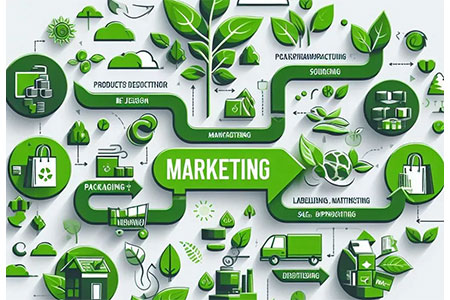Green Marketing
People no longer shop with just their wallets. They shop with their values. That is where green marketing steps in. When a brand takes steps to care for the planet and communicates that effort clearly, it does more than sell a product. It earns trust. Today, the world is watching how companies behave. Buyers support businesses that match their concern for the environment. Brands that embrace this shift are not just doing the right thing, they are setting themselves up for long-term growth.
Let’s dive into what is green marketing and how your brand can use it wisely.
What is Green Marketing?

Green marketing refers to promoting products or services based on their environmental benefits. It focuses on showing how a product is safe for the planet, saves energy, or reduces waste. It is all about making eco-friendly choices and talking about them in a way that connects with people.
It is not just about using the color green or adding a leaf to your logo. Green marketing includes honest efforts to protect the environment. This could mean using fewer natural resources, lowering emissions, or using recyclable materials.
A green marketing definition is simple. It says, “We care, and here’s what we are doing.”
Features of Green Marketing

Features of green marketing include a few clear elements that set it apart:
- Eco-friendly products: These products are made in a way that harms the planet less.
- Sustainable processes: The methods used to make and deliver the product are safe for the environment.
- Clear messaging: The company clearly explains how it helps the planet.
- Long-term thinking: Green marketing is not about quick wins. It looks at how the brand will stay responsible for years to come.
- Genuine intent: It is about real actions, not empty words. The goal is to help, not just to sell.
How Does Green Marketing Work?

Green marketing starts with real changes inside the company. First, the business needs to look at its products, packaging, and processes. Are they wasteful? Can they be cleaner or safer?
Once changes are made, the company shares this with the public. This can be done through labels, websites, ads, and social media. But the message must be clear and honest. No one likes to be misled.
It also includes getting certified by trusted environmental groups. For example, if a product is organic or cruelty-free, the company should show proof. These labels build trust.
Behind the scenes, green marketing works only when every part of the company plays along. From the factory to the delivery truck, every step matters.
Pros and Cons of Green Marketing
| Pros | Cons |
|---|---|
| Builds trust with customers | Can be expensive to implement |
| Attracts eco-aware buyers | Hard to prove environmental claims |
| Encourages innovation | Risk of being accused of greenwashing |
| Supports long-term brand loyalty | May not appeal to all market segments |
| Helps the planet | Needs ongoing effort and investment |
The advantages of green marketing can outweigh the downsides if done sincerely.
Importance of Green Marketing
People today are more aware than ever. They read labels, ask questions, and check if a brand lives by its words. This change in behavior highlights the importance of green marketing.
Businesses that focus on the planet often see a boost in customer loyalty. People want to support brands that reflect their values. This means being eco-friendly can be a strong selling point.
The objective of green marketing is not only to drive sales but also to promote responsibility. For younger buyers, this is even more important. Many of them choose brands based on their environmental and social values. Green marketing speaks directly to them.
It also helps businesses prepare for the future. New laws are coming that will demand cleaner business practices. Starting now means your brand stays ahead.
Green Marketing Strategies
There are many ways to practice green marketing. The key is to take real action first, then talk about it in a clear and honest way.
Developing Eco-Conscious Product Lines
Create products that are safe for the planet. Use fewer chemicals. Design them to last longer. Think of how people can reuse or recycle them. Show these efforts on your packaging and marketing.
Sourcing Raw Materials from Sustainable Suppliers
Pick partners who care about the environment too. Use raw materials that are farmed or mined in a way that does not hurt nature. Choose suppliers who use clean energy or limit waste.
Reducing Product Packaging and Using Recyclable Materials
Say more with less. Cut down on packaging. Use materials that are easy to recycle. Avoid plastics. Your customers will notice and appreciate it.
Emphasizing Digital Campaigns to Reduce Paper Waste
Skip paper when possible. Use email, social media, and websites to share your message. Digital campaigns save trees and money too. They also reach more people, faster.
Adopting Energy-Efficient Practices
Look at how your office, store, or factory uses energy. Switch to LED lights. Use machines that consume less power. Small changes add up and show your values.
Implementing Carbon-Conscious Shipping Methods
Shipping causes pollution. Choose delivery partners that use cleaner fuels or electric vehicles. Ship in bulk where possible to lower the number of trips. Let your customers know that you care.
Building Partnerships with Environmentally Focused Organizations
Work with groups that protect the planet. Sponsor a tree-planting drive. Join a clean-up project. These actions show that your brand wants to make a real difference.
Examples of Green Marketing
Here are a few green marketing examples that show real success:
Patagonia: This clothing brand openly encourages customers to buy less. They run campaigns asking people to repair clothes instead of replacing them. Their honesty and commitment have built a loyal fan base.
Tesla: Known for its electric cars, Tesla markets not just speed or style, but a future without fuel. Their clean energy message is clear in everything they do.
The Body Shop: They focus on cruelty-free beauty. Their stores and packaging reflect a strong green message. They also support various environmental causes.
Seventh Generation: This cleaning brand promotes safe products for people and the planet. Their labels tell buyers exactly what is inside. They also work to reduce waste at every stage.
IKEA: This global furniture brand has started using more renewable materials and has invested in wind and solar energy. They also encourage customers to recycle old furniture.
These brands show the real benefits of green marketing when it is backed by honest action.
What is Greenwashing?

Greenwashing is when a company pretends to be eco-friendly but is not. It is a trick to fool buyers into thinking the product is good for the planet. The company may use green colors, natural words, or false claims to look responsible.
For example, a product may say “natural” or “eco-safe” on the label, but the company cannot prove it. Or a brand may highlight one small green action while ignoring bigger problems.
Greenwashing can damage a brand. Once customers find out, they feel cheated. Trust is lost, and it is hard to win back.
To avoid greenwashing:
- Be honest
- Show real proof
- Get Certified
- Share clear data
Doing the right thing is better than faking it. Your customers will respect the truth.
Conclusion
Green marketing is more than a smart move. Brands that make this shift now will win hearts, build trust, and stay ahead of the curve.
But the effort must be real. It is not about loud claims or empty words. It is about making meaningful changes and being open about them.
If your business wants to make a lasting mark, go green with purpose.
At Excellent Publicity, we help brands share their green journey with the world. Whether you are just starting or want to improve your message, we are here to make it count.
FAQs
Green marketing helps consumers choose brands that match their values. When people see honest efforts to protect the environment, they feel good about their purchase. It builds trust, and loyalty, and encourages customers to support businesses that care about the planet.
Yes, any company can use green marketing. But it only works if the brand truly follows eco-friendly practices. People quickly spot fake claims, so honesty and real effort matter most when trying to win over eco-aware customers.
To avoid greenwashing, companies should make real changes, back claims with proof, and be open about what they do. Avoid vague words and instead focus on results. Third-party certifications and clear information build trust with customers.
Look for official seals, clear ingredient lists, and transparent practices. Real green brands explain what they’re doing and why. If a product makes big promises but gives no proof, it might not be as eco-friendly as it seems.
Regulations make sure that green claims are honest and clear. Laws in many countries now require proof of eco-friendly messages. These rules help protect consumers from false advertising and push companies to be more transparent.



